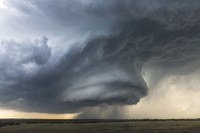
A supercell thunderstorm formed near Hico, Texas. Penn State researchers found in a new study that combining data from new geostationary satellites and Doppler radar provided the best forecasts of a supercell thunderstorms event in 2017 in the Midwest. IMAGE: "HICO SUPERCELL" BY KELLY DELAY, CC BY-NC 2.0 / CREATIVE COMMONS
Matthew Carroll, November 04, 2019
UNIVERSITY PARK, Pa. — Every minute counts when it comes to predicting severe weather. Combing data from cutting-edge geostationary satellites and traditional weather radar created a path toward earlier, more accurate warnings, according to Penn State researchers who studied supercell thuderstorms in the Midwest.
“We know satellites have an advantage in producing forecasts earlier, and radar has more confidence in where clouds should be and where thunderstorms will be moving,” said Yunji Zhang, assistant research professor in meteorology and atmospheric sciences at Penn State. “The question was whether these two types of observations would complement each other if combined together. We found, for at least one severe weather event, assimilating satellite and radar simultaneously leads to the best forecasts.”
Read more:
Combining satellites, radar provides path for better forecasts

